Erklärung der CPU
- CPU steht für "central processing unit", also Zentrale Verarbeitungseinheit. Der Hauptprozessor.
- Der Hauptprozessor ist die Funktionseinheit in einem Computer, der die eigentliche Verarbeitungsleistung erbringt.
- Er ist für die Informationsverarbeitung und die Steuerung der Verarbeitungsabläufe zuständig.
Mooresches Gesetz
1965 formulierte Gordon Moore das Mooresches Gesetz, welches kein Naturgesetz, sondern eher eine Faustformel ist.
Nach diesem Gesetz verdoppelt sich die Anzahl von Transistoren pro Flächeneinheit ca. alle 12 - 24 Monate.
Die Entwicklung der CPU
Tabelle über das Wachstum
| Datei |
Einführungsjahr |
Hersteller |
Model / Codename |
Anzahl Transistoren (ca.) |
Verarbeitungsbreite |
Kerne |
Threads |
Taktfrequenz |
Strukturgröße
|
 |
1975 |
Intel |
8080 |
6.000 |
8-Bit |
1 |
1 |
1-2MHz |
6 μm
|
 |
1978 |
Intel |
8086 |
29.000 |
16-Bit |
1 |
1 |
4,77-10MHz |
3 μm this + Blockschaltbild
|
 |
1980 |
Intel |
8088 |
29.000 |
16-Bit |
1 |
1 |
5-10MHz |
3 μm
|
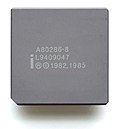 |
1982 |
Intel |
80286 |
134.000 |
16-Bit |
1 |
1 |
4-26MHz |
1,5 μm
|
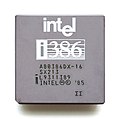 |
1985 |
Intel |
80386 |
275.000 |
32-Bit |
1 |
1 |
12-40MHz |
1,5 μm bis 1,0 μm this
|
 |
1989 |
Intel |
80486 |
1.180.000 |
32-Bit |
1 |
1 |
16-100MHz |
1 μm bis 0,6 μm
|
 |
1993 |
Intel |
Pentium |
3.100.000 |
32-Bit |
1 |
1 |
60-66MHz |
0,8 μm this
|
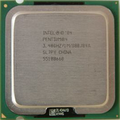 |
2004 |
Intel |
Pentium 4 "Prescott" |
125.000.000 |
64-Bit |
1 |
1-2 |
1,3-3,8GHz |
0,90 μm
|
 |
2007 |
Intel |
Core 2 "Wolfdale" |
410.000.000 |
64-Bit |
4 |
4 |
1,3-3,33 GHz |
0,45 μm
|
 |
2008 |
Intel |
i7 Nehalem "Bloomfield" |
731.000.000 |
64-Bit |
4 |
4 |
2,6-3,2 GHz |
0,45 μm
|
 |
2009 |
Intel |
i5 Nehalem "Lynnfield" |
774.000.000 |
64-Bit |
4 |
4 |
2,66-3,06 GHz |
0,45 μm
|
 |
2010 |
Intel |
i7 Westmere "Gulftown" |
1.170.000.000 |
64-Bit |
6 |
6 |
3,2-3,46 GHz |
0,32 μm
|
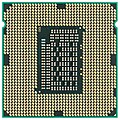 |
2011 |
Intel |
i7 Sandy Bridge |
1.160.000.000 |
64-Bit |
4 |
4 |
2,8-3,5 GHz |
0,32 μm
|
 |
2012 |
Intel |
i7 Ivy Bridge |
1.400.000.000 |
64-Bit |
4 |
4 |
2,5-3,5 GHz |
0,22 μm
|
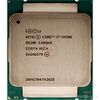 |
2014 |
Intel |
i7 Haswell-E |
2.600.000.000 |
64-Bit |
6 |
12 |
3,0-3,7 GHz |
0,22 μm
|
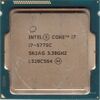 |
2015 |
Intel |
i7 Broadwell |
3.200.000.000 |
64-Bit |
4 |
8 |
3,3-3,7 GHz |
0,14 μm
|
 |
2015 |
Intel |
i7 Skylake-S |
1.750.000.000 |
64-Bit |
4 |
8 |
3,8-4,0 GHz |
0,14 μm
|
 |
2017 |
Intel |
i7 Skylake-X |
keine Angabe |
64-Bit |
6 |
12 |
3,5-4,0 GHz |
0,14 μm
|
 |
2018 |
Intel |
i7 Coffee Lake-S |
keine Angabe |
64-Bit |
6 |
12 |
4,0-5,0 GHz |
0,14 μm
|
 |
2019 |
Intel |
i9 Cascade Lake |
keine Angabe |
64-Bit |
18 |
36 |
3,0-4,7 GHz |
0,14 μm
|
 |
2020 |
Intel |
i9 Comet Lake-S |
keine Angabe |
64-Bit |
10 |
20 |
3,7-5,3 GHz |
0,14 μm
|
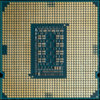 |
2021 |
Intel |
Rocket Lake |
keine Angabe |
64-Bit |
8 |
16 |
3,5-5,3GHz |
0,14 μm
|
1µ (ein Mikron) = ein millionstel.
1µm (ein Mikrometer) = 1/1000 Millimeter.
Intel 8086
- Einführung im Jahr 1978.
- 1 Kern, 16-Bit, 4,77MHz
- kein Cache
- basierend auf Intels 8-Bit CPU
- besitzt einen Minimum- und einem Maximummodus
Blockschaltbild Intel 8086

Nennenswertes
Intel 80386
- Einführung im Jahr 1985.
- 1 Kern, 32-Bit, 12MHz
- kein Cache
- auch als i386 bekannt
- vollzog den Wechsel zur 32-Bit-Architektur
Blockschaltbild Intel 80386

Nennenswertes
Intel Pentium
- Einführung im Jahr 1993
- 1 Kern, 32-Bit, 60MHz
- 16 KiB Cache
- der erste superskalare CISC-Mikroprozessor der Welt
Blockschaltbild Intel Pentium

Nennenswertes
Intel Core FEHLT
Blockschaltbild Intel Core FEHLT
FEHLT
Nennenswertes
Quellen
























